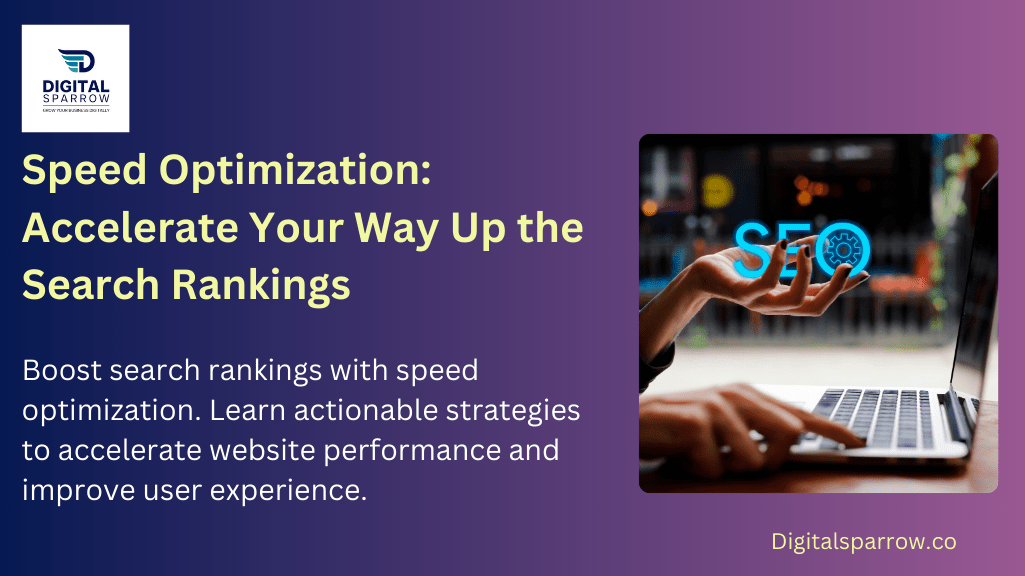Introduction
In today’s fast-paced digital landscape, speed is everything. Whether you’re browsing the web or managing a website, the need for speed is non-negotiable. Speed optimization has become a crucial factor not only for providing a seamless user experience but also for climbing the search engine rankings. In this article, we’ll delve deep into the world of speed optimization, exploring its significance and providing actionable strategies to accelerate your way up the search rankings.
Why Speed Matters?
Speed matters in the digital world for two primary reasons: user experience and search engine rankings.
- User experience is heavily influenced by speed. Slow-loading websites annoy visitors, resulting in higher bounce rates and lower engagement. Users of the internet nowadays expect instant and seamless access to information, products, and services. A slow website can harm your brand’s reputation and turn away potential customers. A quick website, on the other hand, promotes user pleasure, encourages longer visits, and raises the possibility of conversions.
- The importance of speed in search engine rankings cannot be overstated. Google and other major search engines prioritise user experience in their algorithms. They understand that slow websites offer a poor user experience and tend to rank them lower in search results. Fast-loading websites, on the other hand, are rewarded with higher rankings. As a result, speed optimisation isn’t only about impressing your audience; it’s also about meeting search engines’ visibility and discoverability standards. A higher search ranking means more organic visitors, which can increase your online presence and commercial success. In today’s competitive digital landscape, speed is a critical component that must not be disregarded.
Technical SEO Fixes-https://digitalsparrow.co/boost-website-performance-technical-seo-fixes/
Measuring Website Speed
Measuring website speed is essential for understanding how quickly your web pages load and how efficiently your website performs. Several key metrics help gauge website speed:
- Page Load Time: This metric represents the total time it takes for a web page to fully load in a user’s browser. It encompasses all elements, including text, images, scripts, and styles. Ideally, pages should load in a matter of seconds to provide an excellent user experience.
- Time to First Byte (TTFB): TTFB measures the time it takes for a user’s browser to receive the first byte of data from the web server. It reflects the server’s responsiveness and can affect the initial page rendering time. A fast TTFB ensures a quicker start to the loading process.
- Render Time: This metric measures the time it takes for a web page to be fully rendered and interactive for users. A fast render time is crucial for delivering a seamless user experience, as it allows users to start interacting with the page sooner.
Various tools are available to examine these parameters and optimise the speed of your website, including Google’s PageSpeed Insights, GTmetrix, and WebPageTest. These programmes generate comprehensive reports that suggest areas for improvement such as image optimisation, code minification, and server response time reduction. You may improve customer satisfaction, minimise bounce rates, and improve your website’s overall performance and search engine results by routinely monitoring and optimising key speed-related data. Keep in mind that in the digital age, every second matters.
Speed Optimization Strategies
Speed optimization is crucial for delivering a fast and efficient user experience on your website. Here are key strategies to improve website speed:
- Content Delivery Network (CDN): Implement a CDN to distribute website content across multiple servers worldwide. This reduces the geographic distance between users and servers, resulting in faster load times regardless of location.
- Optimize Images and Media: Compress and resize images and videos to reduce their file size. Implement responsive design and use lazy loading techniques to ensure media elements load only when needed.
- Minimize HTTP Requests: Reduce the number of HTTP requests by combining CSS and JavaScript files, using asynchronous loading, and minimizing the use of external resources. Fewer requests mean faster load times.
- Enable Browser Caching:Configure your server to instruct browsers to cache static assets such as pictures, stylesheets, and scripts. This lowers the need for repeat downloads when people return to your site.
- Optimise Code: Make sure your website’s code is clean, concise, and well-structured. Reduce redundant code, remove unused plugins, and adhere to recommended development practises to optimise load times.
- Mobile Optimization: Prioritise mobile speed, given the rising use of mobile devices. Implement responsive design, decrease server queries, and use efficient coding to improve mobile performance.
- Hosting and Server Optimisation: Select a reputed hosting provider with fast and dependable servers. Implement server-side caching and content compression to increase performance even further.
- Content Delivery Optimization: Prioritize critical content loading and defer non-essential content. This approach, known as “critical rendering path optimization,” ensures essential elements are displayed quickly.
Continuous Monitoring and Testing
Continuous monitoring and testing are indispensable aspects of maintaining and enhancing website speed and performance.
- Regular performance audits using tools like Google PageSpeed Insights and GTmetrix help identify bottlenecks and areas for improvement. These audits highlight issues such as oversized images, render-blocking scripts, or slow server response times.
- A/B testing is another critical component of ongoing optimization efforts. By experimenting with different speed optimization techniques, you can assess their impact on user engagement, conversion rates, and overall site performance. This allows you to fine-tune your strategies based on real data and user behavior.
User expectations and technology are rapidly changing in the ever-changing digital ecosystem. Continuous monitoring and testing ensure that your website remains competitive while providing a fast, fluid, and delightful user experience. You can maintain high search engine rankings and keep your users delighted by remaining watchful and sensitive to performance data.
Effective marketing techniques-https://startupadvice.in/increasing-the-growth-of-small-business-through-effective-marketing-techniques/
Conclusion
Speed optimization is more than simply a technical concern; it is also an important aspect in boosting user experience and search engine results. You may accelerate your climb up the search rankings and ensure that your website remains competitive in the digital arena by applying the tactics mentioned in this article and remaining careful in monitoring and testing. Remember that quickness is your most trusted ally in the race for online success.


Pingback: The Ultimate Guide to Mobile Optimization for Shopify Stores
I don’t think the title of your article matches the content lol. Just kidding, mainly because I had some doubts after reading the article.
Your article helped me a lot, is there any more related content? Thanks!